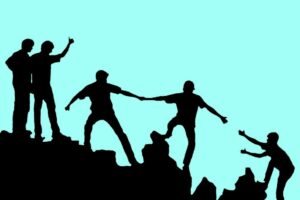By J. Edwin Orr
J. Edwin Orr was a revival scholar at Fuller Seminary and was priveleged to himself participate in several campus awakenings.
Can you imagine one-third of a university’s student body coming to Christ in a single year? Fifty percent of those new believers going into full-time Christian work following graduation?
More than 20,000 students eventually serving Christ overseas due to the influence of a few of these students? Imagine it, because it all happened!
It began in the early 1800s at schools like Amherst, Dartmouth, Princeton, Williams and Yale where up to half the students turned to Christ.
By 1835, 1,500 students had committed their lives to Christ in 36 colleges. Impressive statistics, especially when you realize that in those days student bodies numbered only 100-250. Similar results continued to be seen from one generation of students to the next.
In 1853, 11 New England colleges with a total enrollment of 2,163 reported that there were 745 active Christians on campus. Of this number, 343 planned to go into the ministry. Then in the 1880’s, an unprecedented missionary enterprise, known as the Student Volunteer Movement, came into being.
“The Evangelization of the World in This Generation” became its rallying cry. This spirit was evidenced in the movement’s results – more than 20,000 serving in overseas mission fields in half a century.
College students set the pace in this era of spiritual advance. The full dynamic of their story cannot be fully appreciated, however, apart from a look at the context of its beginnings.
ALL-TIME LOW
In 1790 America had won its independence, but it had lost something as well. In the wake of the Revolutionary War, French infidelity, deism, and the generally unsettled condition of society had driven the moral and spiritual climate of the colonies to an all-time low.
Conditions on campus were no better. A poll taken at Harvard revealed not one believer in the whole student body.
At Princeton, where a similar survey showed there to be only two Christians on campus, when the dean opened the Chapel Bible to read, a pack of playing cards fell out, someone having cut a rectangle from each page to fit the deck.
Conditions on campus had degenerated to the point that all but five at Princeton were part of the “filthy speech” movement of that day.
RADICAL CHANGE
Then, suddenly, at the turn of the century, the nation made a spiritual about-face that affected every level of society — from the frontiers to the college campuses.
Something so radically changed the campuses of America that the same schools which a generation before had mocked the gospel began sending out workers into the harvest! In college after college, students formed similar Christian fellowships.
At Harvard, Bowdoin, Brown, Dartmouth, Middlebury, Williams, and Andover, students began to meet and pray. At Williams College in Massachusetts, The scene of discouraging anti-Christian rioting, there was a small secret band of Christians as well.
Burdened by the deplorable conditions on campus, they met twice a week to pray for revival. Little did they know how abundantly God used these students to make an impact on not only their campus, but also on an entire century?
It was to be through the efforts of the son of one of these students that the Student Volunteer Movement would eventually be launched in the 1800s. However, the beginnings of their global influence for Christ were much less dramatic, as the following account will show.
“WE CAN IF WE WILL”
One hot August afternoon in 1806 these five students hid themselves to pray under the camouflage of a maple grove. As they met, the sky began to darken, and the accompanying thunderstorm and lightning persuaded them to run for cover.
Before they could reach the campus, however, the clouds began to disperse and they were able to continue their meeting under the privacy of a haystack. The group’s leader, freshman Samuel Mills, began to guide the discussion toward the topic of foreign missions.
He contended that it would be impossible for the masses of Asia and Africa to hear the gospel unless the students from Christian nations were willing to dedicate their lives to the cause of the Great Commission.
As he shared his vision for world evangelization, he said, “We can do it if we will,” revealing a determination lacking in the expected, “We will do it if we can.”
Drawn by the challenge of their commitment, this group attracted the “cream” of the student leadership, including the valedictorian of 1809. Four years later they asked their denomination to send them out as missionaries.
Prior to this, there was not a single American engaged in preaching the Gospel overseas. While awakenings in Britain had already led to the formation of missionary societies, American agencies for sending workers into the harvest had not yet been established.
The leadership of the Massachusetts Congregational Churches agreed to help them and formed the American Board of Commissioners for Foreign Missions–the first American organization of its kind.
Shortly after this pioneering venture, many similar agencies were begun by other denominations. All owed their origin to a group of students from Williams College who had caught God’s vision for the world during a prayer meeting.
THE YMCA IS BORN
The revival at Williams and other colleges was part of a far wider movement of the Holy Spirit that affected not only every level of American society but also other countries around the world.
In Britain, where the movement had originally been, in addition to numerous missionary and Bible societies, God raised up the Young Men’s Christian Association in 1844.
The YMCA, which was at first as evangelistic as it was social, provided an organizational structure that would one day link the numerous student Christian groups across America. Through this network the vision and challenge of total world evangelization would eventually spread to thousands of students.
The development of the YMCA for its role in sending student volunteers to the world occurred during another period of world-wide revival from 1857 to 1899. Awakening again broke out as a result of prayer.
Jeremiah Lamphier began a weekly noonday prayer meeting in Manhattan in September 1857. The first week, six attended. The following week there were 14, and by the third, 23, at which time it was decided to meet daily. By March 1958 every church and public hall in down town New York City was filled.
Horace Greley, the famous editor, sent a reporter racing throughout the city by horse and buggy to count how many were attending the prayer meetings. At the 12 locations he was able to get to in an hour, he counted 6,110 people.
By May, 96,000 New Yorkers, 10 percent of the population of one million had received Christ. By the end of the year more than a million throughout the country, 3 percent of the nation’s population of 30 million had turned to Christ.
CAMPUS AWAKENINGS
As during the early part of the century, the awakenings in 1875 and following years quickly spread to America’s colleges. In 1858 at Yale, 204 students–45 percent of the school’s 447 students–received Christ.
As a result of revivals at the University of Michigan and the University of Virginia, the first college YMCAs were begun to mobilize and equip students for effective ministries of evangelism and discipleship.
By 1877 approximately 50 of the 200 student Christian societies scattered across the country were affiliated with the YMCA. That same year the Cambridge inter-collegiate Christian Union was formed to unite the various British student Christian groups.
Then in 1879 Oxford formed its Inter-collegiate Christian Union.
At Princeton in l875 there was no YMCA. However, a student Christian group known as the Philadelphia Society had 110 active members. Luther Wishard, who became the group’s president in 1876, united the society with the growing YMCA movement.
Through his leadership and the student’s prayer, evangelist D. L. Moody was persuaded to conduct a series of evangelistic meetings on campus. As a result, nearly a third of the student body received Christ. Among those working in the Princeton YMCA were some of the most outstanding campus leaders.
One such student evangelist was Tommy Wilson, who eventually became president of the university. Later still he became better known as T. Woodrow Wilson, the 28th President of the United States.
Luther Wishard’s efforts extended beyond the ministry at Princeton. In 1877 he spearheaded the formation of a separate intercollegiate division of the YMCA. As the organizations first full-time secretary he was instrumental in establishing student associations nationwide. By 1890 there were more than 250 college YMCA’s with 12,000 members.
THE STUDENT VOLUNTEER MOVEMENT
Thus by the 1880’s the stage was set for an unprecedented thrust forward toward the fulfillment of the Great Commission. It would be from this vast reservoir of students associated with the YMCA that the Student Volunteer Movement for Foreign Missions would arise.
The key figure in the movement’s birth was the son of Royal Gould Wilder, who had participated in the 1806 haystack prayer meeting at Williams College. After more than 30 years of missionary work in India, the Wilder family had returned to America where young Robert eventually enrolled at Princeton.
While there, Robert P. Wilder, Phi Beta Kappa scholar, as well as Christian activist, was instrumental in beginning the Princeton Foreign Missionary Society in 1883.
Members of this group signed a covenant pledging “We, the undersigned, declare ourselves willing and desirous, God permitting, to go to the unevangelized portions of the world.” They adopted a watchword which expressed their objective, “The Evangelization of the World in this Generation.”
Having inherited his missionary father’s world vision and burden for those without Christ, in 1886 the younger Wilder influenced 100 students to dedicate their lives to missionary services during a summer YMCA conference at Mount Hermon, Dwight L. Moody’s retreat grounds in Northfield, Massachusetts.
Encouraged by what God had done and wanting to capitalize on this momentum, Wilder and a fellow Princeton graduate, John Forman, traveled from school to school the next year to recruit more volunteers. By 1888 over 3,000 had pledged themselves to the cause of foreign missions.
Thus, while God had used the YMCA to mobilize Christian students into campus chapters, the Princeton Foreign Missionary Society grew into the Student Volunteer Movement, which was used to send them into the harvest, Robert Wilder’s father had been praying that a thousand students from American colleges would be raised up.
God answered powerfully as more than 20,000 set sail over the life of the movement!
On college campuses during the 19th century, God revived generation after generation of students and used them to move the church closer to the fulfillment of the Great Commission. They first pioneered work along the coastlands of Africa and Asia.
Then by 1886 a second era of Protestant missions saw footholds established in the vast inland territories of those lands through thousands of student volunteers. As today’s students are sensitive to the conviction and call of the Holy Spirit, perhaps they can match their predecessors’ faith and actions.
Could it be that a movement of 20th-century volunteers and national believers might make this the third an final era of missions! Perhaps the volunteers’ objective, “The Evangelization of the World in This Generation,’ will be realized during your lifetime.





Really touching